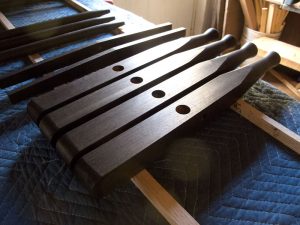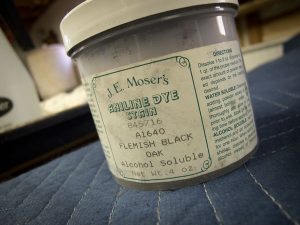We may receive a commission when you use our affiliate links. However, this does not impact our recommendations.
When I finish my pieces, I use restraint when adding stains or dyes. Most woods look best (to my eye) with some shellac, lacquer and maybe a little colored wax in the pores.
But when I do color wood, I’m a fan of the W.D. Lockwood dyes, which are usually found packaged as J.E. Moser dyes from Woodworker’s Supply. I have to thank Glen D. Huey for introducing me to these dyes when we first started working with him as a contributor at Popular Woodworking Magazine.
Glen uses the dyes with stunning results on figured woods.
I started using the dyes on Arts and Crafts furniture – I would dye the wood a strong red and then apply a brown coat of stain over the wood. The result was that the medullary rays would end up as red but the piece would have the familiar overall brown color. Not everyone likes this look, but I do.
Today I’m using the Flemish Black Oak dye to ebonize some mahogany legs for a Kaare Klint Safari Chair – the final project in my forthcoming book, “Campaign Furniture.” As I was applying the dye, I remembered a few things that weren’t on the instructions. So if you’ve never used dye, here are a few tips.
1. The water-base dye is more light-fast than the alcohol-based. If your piece will live in the sun, you might not want to use dyes at all (pigment stain would be better; it doesn’t fade). However, the alcohol stuff is very fast-drying. All my dye will be dry by the time I finish this blog entry (30 minutes). The water-base stuff takes a lot longer to dry.
2. Soak the wood. Don’t be stingy. Spray a heavy coat or wipe on a heavy coat, especially with open-pore species. Dip small parts in the dye.
3. After it dries, take a clean, dry rag and burnish off the extra dye powder. Sometimes your project will look blotchy after you have dyed it. Usually the blotches are just extra powder that was not absorbed into the wood. A clean, dry rag will fix the problem. Rub vigorously.
4. If the project looks freaky when it dries, don’t freak. Some of these dyes turn Pepto pink when they dry. Don’t fret. When you add the topcoat, the color of the wet dye will return.
There are lots of other things you can do with dyes – I like using them to tone lacquer or shellac. But I have to go finish my legs right now.
— Christopher Schwarz
Here are some supplies and tools we find essential in our everyday work around the shop. We may receive a commission from sales referred by our links; however, we have carefully selected these products for their usefulness and quality.












What can I say Chris other than “You Killed It ! “
I wanted to dye some curly maple before assembly. If the wood inside the joints gets dyed will it affect the adhesion of glue? Anyone know?
7-Thumbs,
During WW II, a question about dyeing human legs would not have been a joke. When silk for women’s stockings was not available, some women dyed their legs a darker shade to imitate stockings, and since the stockings usually had a seam at the back, there were devices to draw an even darker line up the back of the leg. It may sound silly now, but not nearly as much as some of the current shoes with heels so high they make the wearer walk on tip-toes!
I just attended a neat art show where the artists had used dyes rather than stains. I was wondering where to get good dyes and how to use them. Thanks for reading my mind. P.S. the legs look lovely. I’ll have to try your technique with the red first. I tried it with stains several years ago and the look was interesting but still needed some work.
When you say “I have to go finish my legs right now”, do you mean the furniture legs or your legs. If your legs what dye do you use?